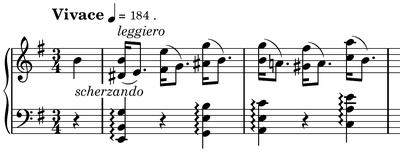
Étude Op. 25, No. 5 (Chopin)
Encyclopedia

E minor
E minor is a minor scale based on the note E. The E natural minor scale consists of the pitches E, F, G, A, B, C, and D. The E harmonic minor scale contains the natural 7, D, rather than the flatted 7, D – to align with the major dominant chord, B7 .Its key signature has one sharp, F .Its...
, is a technical study composed by Frédéric Chopin
Frédéric Chopin
Frédéric François Chopin was a Polish composer and virtuoso pianist. He is considered one of the great masters of Romantic music and has been called "the poet of the piano"....
in 1837. Marking a serious departure in the expected technique developed previously, Chopin wrote this étude with a series of quick minor second
Semitone
A semitone, also called a half step or a half tone, is the smallest musical interval commonly used in Western tonal music, and it is considered the most dissonant when sounded harmonically....
s that produce slightly dissonant
Consonance and dissonance
In music, a consonance is a harmony, chord, or interval considered stable, as opposed to a dissonance , which is considered to be unstable...
sounds. The effect has earned the étude the nickname "Wrong Note".
Structure
After the first themeTheme (music)
In music, a theme is the material, usually a recognizable melody, upon which part or all of a composition is based.-Characteristics:A theme may be perceivable as a complete musical expression in itself, separate from the work in which it is found . In contrast to an idea or motif, a theme is...
of 'minor seconds' closes, Chopin introduces a Più Lento section in which a new melody is played in the parallel key
Parallel key
In music, parallel keys are the major and minor scales that have the same tonic. A major and minor scale sharing the same tonic are said to be in a parallel relationship...
, E major
E major
E major is a major scale based on E, with the pitches E, F, G, A, B, C, and D. Its key signature has four sharps .Its relative minor is C-sharp minor, and its parallel minor is E minor....
. This section is played consonantly, without dismelodious sounds such as the minor second. The final section of the piece starts with a recapitulation
Recapitulation
Recapitulation may refer to:* Recapitulation , a section of musical sonata form where the exposition is repeated in an altered form and the development is concluded...
of the first theme, with climaxes in a coda
Coda (music)
Coda is a term used in music in a number of different senses, primarily to designate a passage that brings a piece to an end. Technically, it is an expanded cadence...
played in E Major.
The second section is marked as Più Lento (It.
Italian language
Italian is a Romance language spoken mainly in Europe: Italy, Switzerland, San Marino, Vatican City, by minorities in Malta, Monaco, Croatia, Slovenia, France, Libya, Eritrea, and Somalia, and by immigrant communities in the Americas and Australia...
More Slow) despite Chopin's metronome
Metronome
A metronome is any device that produces regular, metrical ticks — settable in beats per minute. These ticks represent a fixed, regular aural pulse; some metronomes also include synchronized visual motion...
mark of ♩=168, a very quick tempo
Tempo
In musical terminology, tempo is the speed or pace of a given piece. Tempo is a crucial element of any musical composition, as it can affect the mood and difficulty of a piece.-Measuring tempo:...
.
Étude Op. 25, No. 5 features an unusual overall structure, surrounding a major second theme, with the minor main theme. This idea appears only one other time in Chopin's set, in Étude Op. 25, No. 10. Styling the études in this fashion further emphasizes Chopin's deviation from the standard set before him by composers such as Carl Czerny
Carl Czerny
Carl Czerny was an Austrian pianist, composer and teacher. He is best remembered today for his books of études for the piano. Czerny's music was profoundly influenced by his teachers, Muzio Clementi, Johann Nepomuk Hummel, Antonio Salieri and Ludwig van Beethoven.-Early life:Carl Czerny was born...
. Both are structured much like the sonatas
Piano sonata
A piano sonata is a sonata written for a solo piano. Piano sonatas are usually written in three or four movements, although some piano sonatas have been written with a single movement , two movements , five or even more movements...
of Ludwig van Beethoven
Ludwig van Beethoven
Ludwig van Beethoven was a German composer and pianist. A crucial figure in the transition between the Classical and Romantic eras in Western art music, he remains one of the most famous and influential composers of all time.Born in Bonn, then the capital of the Electorate of Cologne and part of...
, in which Beethoven set apart three movements in this same structure.

